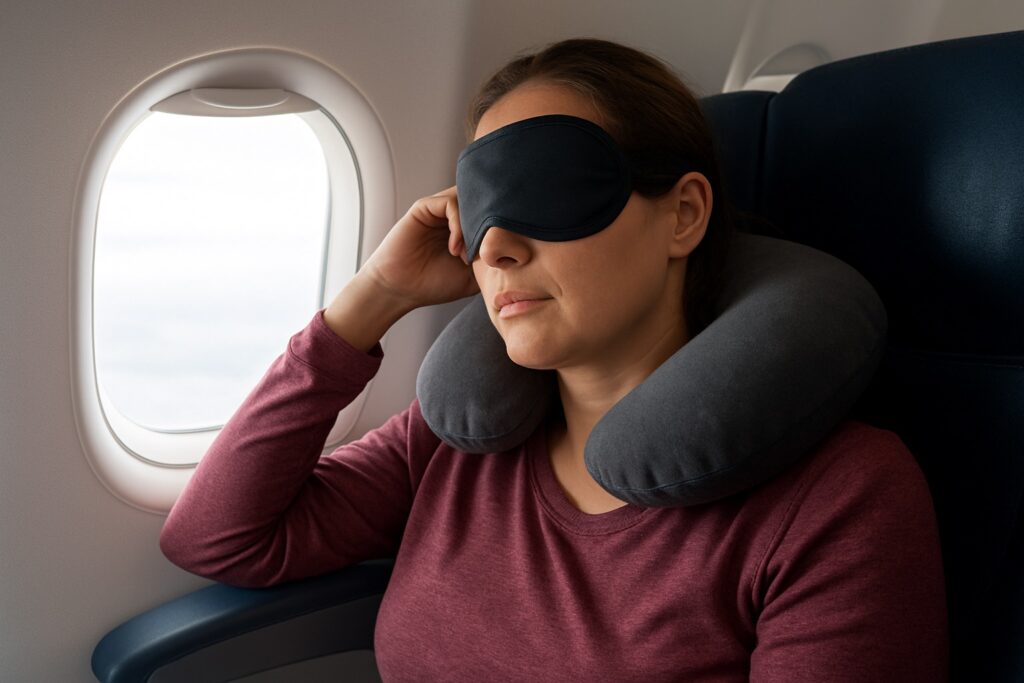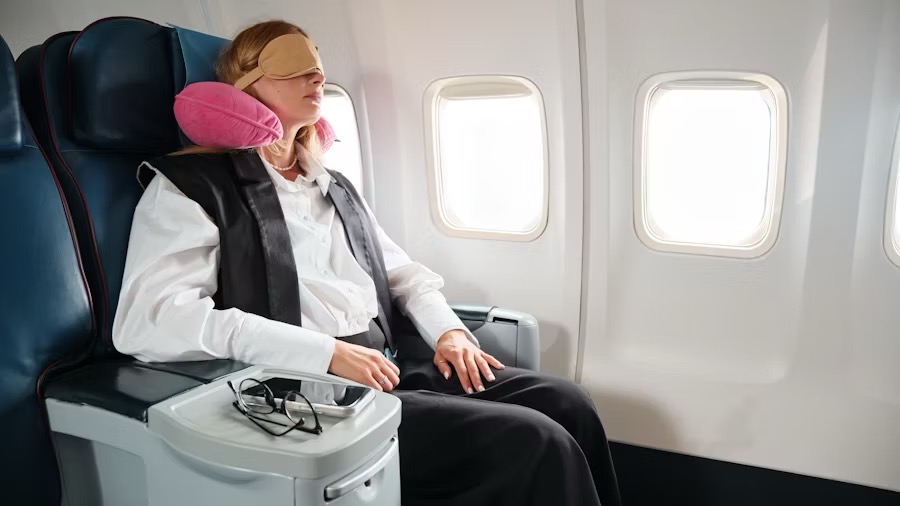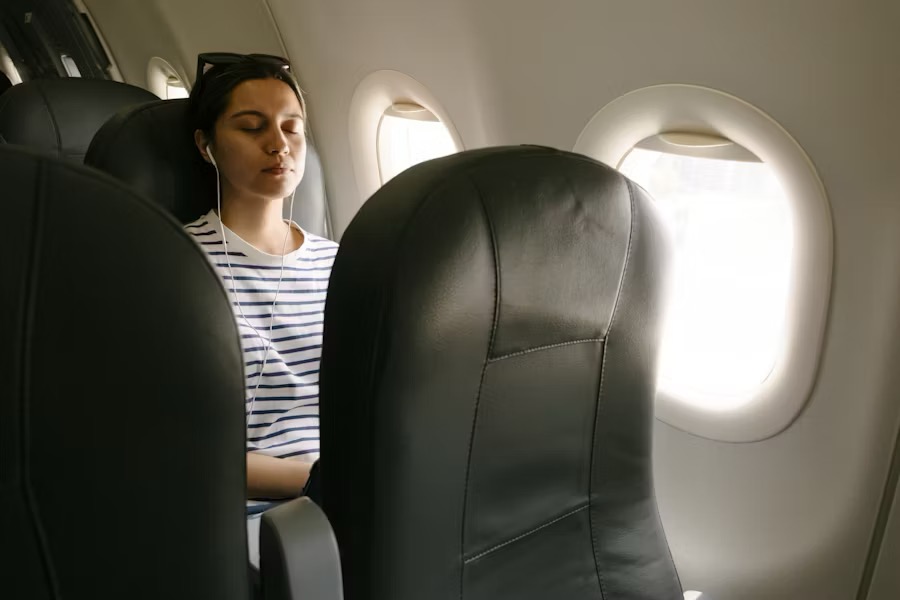If you’ve ever boarded a flight with the lofty goal of “just sleeping through it,” only to find yourself wide awake, stiff, and counting down the hours until landing, you’re not alone. For most of us, going to sleep on a plane feels impossible—between cramped seats, engine noise, fluctuating temperatures, and the occasional beverage cart rolling by.
But good news: sleeping in the air is a skill, and like any skill, you can get better at it with the right preparation and strategies. Whether you’re flying across the country or halfway around the world, here’s how to finally get that elusive in-flight rest—even if you’ve never been able to before. Sleep on a plane well….
1. Choose Your Seat Like Your Sleep Depends on It (Because It Does)
Not all airplane seats are created equal. If your goal is to sleep on a plane, your seat selection matters as much as the pillow you bring.
- Window Seat Wins: You have a wall to lean against, control over your light exposure (shade down), and no seatmates climbing over you for restroom breaks.
- Avoid the Back Rows: They’re near the galley and bathrooms, which means more noise, light, and foot traffic.
- Stay Away from the Wings (If Noise Bothers You): The engines are loudest here. If you’re sensitive, pick a seat toward the front of the cabin.
- Use Seat Selection Tools: Websites like SeatGuru can help you find seats with extra legroom or fewer disruptions.

2. Dress for Sleep Success
You wouldn’t wear jeans to bed at home, so don’t expect to sleep in them on a plane. Opt for breathable, stretchy fabrics.
- Layers Are Your Friend: Cabin temperatures can shift from warm to chilly, so wear a light T-shirt, a cardigan or hoodie, and bring a travel blanket or oversized scarf.
- Compression Socks: These not only help with circulation but also keep your feet warm—key for falling asleep.
- Slip-On Shoes: You can easily remove them for comfort but still slip them back on quickly if you need to get up.
3. Create Your Own Sleep Bubble
The reality is that planes are not really designed for sleep, but you can create your own mini-sleep sanctuary.
- Neck Pillow Upgrade: Skip the flimsy U-shapes you see in airport kiosks. Try a memory foam travel pillow, a wrap-around style, or even an inflatable one for better support.
- Eye Mask: Go for a contoured mask that blocks out all light without pressing on your eyelids.
- Noise Control: Active noise-canceling headphones or soft foam earplugs make a huge difference. Pair with white noise, pink noise, or a calming playlist.
- Blanket or Shawl: Even on short flights, the comfort factor helps you relax faster.

4. Time Your Meals and Drinks
A little pre-flight planning with food and drink can make getting to sleep on a plane much easier.
- Skip the Heavy Pre-Flight Meal: Digesting a big dinner mid-air can leave you uncomfortable and restless. Opt for something light but satisfying.
- Hydrate Smartly: Drink water steadily throughout the day before your flight, but avoid overloading right before boarding to minimize bathroom trips. Bring a water bottle to sip during the flight as well.
- Avoid Alcohol and Caffeine: Alcohol might make you feel drowsy, but it disrupts your sleep cycles. Caffeine can linger in your system for hours. Herbal tea is a much better option.
5. Signal to Your Body It’s Bedtime
Even though you’re sitting at 35,000 feet, you can still trick your body into thinking it’s time to sleep.
- Follow Your Bedtime Routine: If you normally read before bed, bring a Kindle or book. Wash your face and brush your teeth right before boarding or once you’re in the air.
- Dim the Lights Early: Close your window shade, put on your mask, and limit screen time from phones or seat-back entertainment. We also bring blue light glasses with us to put on as we are settling in.
- Use Relaxation Techniques: Try deep breathing, progressive muscle relaxation, or a short meditation track.

6. Pick the Right Sleep Aid (If You Need One)
Some travelers benefit from gentle sleep aids, while others prefer to keep it natural.
- Natural Options: Melatonin can help if you’re crossing time zones, especially for adjusting your circadian rhythm.
- Over-the-Counter: Some people use antihistamines like diphenhydramine (sleep aid or Benadryl) to sleep on a plane, but these can cause grogginess.
- Prescription Medications: Always consult your doctor before using stronger options like Ambien or Lunesta, and test them at home first.
- Non-Medication Help: Products like lavender aromatherapy sprays or magnesium supplements can promote relaxation without side effects.
7. Recline Without Regret
Seat reclining is a hot-button topic in travel etiquette, but if you’re going to sleep on a plane, a slight recline is essential.
- Be Considerate: Recline slowly, and check behind you before you do.
- Support Your Lower Back: Use a small pillow or rolled-up sweater to maintain spinal comfort.
- Tilt Your Head Slightly Forward or Sideways: This can prevent that dreaded “head bob” that wakes you up.

8. Match Your Body Clock to Your Destination
If you’re flying overnight or internationally, syncing your internal clock to your arrival time helps you sleep better on the plane.
- Start Adjusting Before You Fly: Shift your bedtime by 30–60 minutes for a few nights before departure.
- Use Light Exposure: Once onboard, adjust your lighting to match your destination—bright when you want to stay awake, dark when you want to sleep. Blue Light Glasses also help in this case as well.
- Avoid Meals at Odd Hours: Eating on your new schedule can help convince your body to cooperate.
9. Protect Your Sleep Once You Have It
Finally, once you doze off, the goal is to stay asleep as long as possible.
- Fasten Your Seatbelt Over Your Blanket: This way, flight attendants won’t wake you to check if you’re buckled.
- Let Seatmates Know You’re Sleeping: A quick, polite mention before you nod off helps prevent unnecessary taps on the shoulder.
- Set an Alarm for Wake-Up: If you want to freshen up before landing, this prevents you from oversleeping and rushing.

Final Thoughts – Sleep on a Plane
Sleeping on a plane might never feel as blissful as drifting off in your own bed, but with the right preparation, you can make it restful enough to arrive refreshed and ready for adventure.
Think of it as building a personal sleep toolkit: the perfect seat, comfortable clothing, the right gear, mindful eating and drinking, and a few tried-and-true relaxation techniques. Once you’ve mastered these, even the longest flights can become a little more restful—and a lot less exhausting.
Next time you step onboard, you’ll be ready to settle in, block out the world, and get the kind of in-flight sleep you used to think was impossible.
See also:
*This post contains affiliate links. We may receive a small commission but there is NEVER a cost to you.

